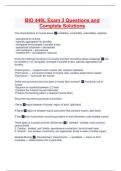Exam (elaborations)
BIO 446L Exam 3 Questions and Complete Solutions
- Course
- Institution
The characteristics of muscle tissue excitability, contractility, extensibility, elasticity - specialized to contract - typically aggregated into bundles - elongated and arranged in parallel arrays - specialized cytoplasm = sarcoplasm - cell membrane = sarcolemma - modified ER = sarcoplasmic retic...
[Show more]



